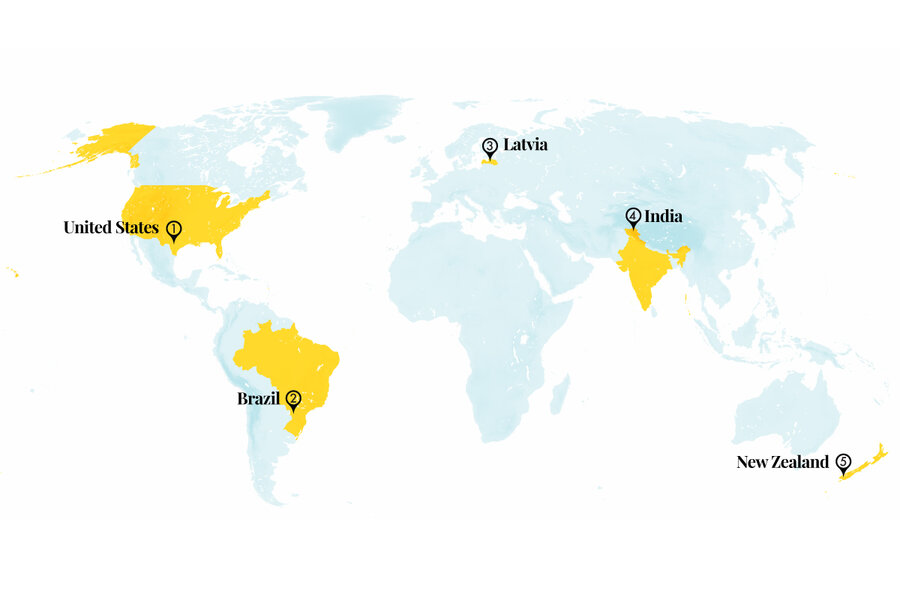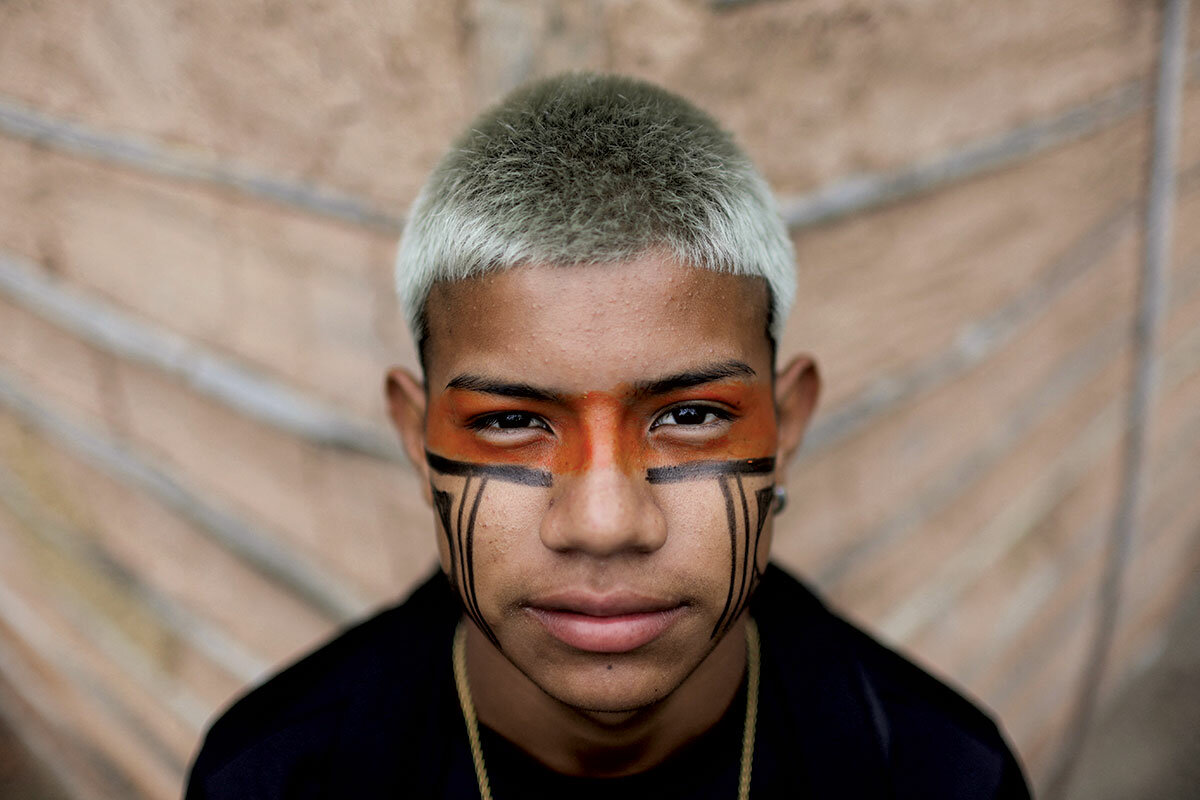Where old ideas fuel modern solutions
1. United States
A home water treatment using Navajo pottery combines novel engineering with Native American knowledge. After decades of commercial mining in the area, much of the Navajo Nation in the Southwest lacks access to clean drinking water. So scientists from the University of Texas at Austin partnered with a third-generation Navajo potter, Deanna Tso, to create a solution that combines locally sourced pine resin with silver nanoparticles for purification.
While silver is often used in ceramic water filters due to its antimicrobial properties, some filters can quickly lose their effectiveness as silver particles degrade. By incorporating pine resin, a material commonly used as a glaze by Navajo potters, that degradation can be remediated.
Why We Wrote This
From “ice stupas” in India to water purification systems for members of the Navajo Nation in the United States, modern solutions to water woes are drawing inspiration from local artistic traditions. A progress roundup.
Each pot cost less than $10 to create, making it a potentially low-cost solution for those without access to clean water. The lab hopes to develop other technologies for Indigenous communities in Alaska, southern Mexico, and Bangladesh.
“The uniqueness of this technology is its integrated knowledge of the target community and consideration of their cultural norm and ethos prior to designing a solution for them,” said Navid Saleh, a co-author of the paper and whose course teachings have included implementation of science in underserved communities. “This is one of the strengths that most technologies do not do.”
Sources: University of Texas Libraries, American Society of Mechanical Engineers
2. Brazil
Indigenous teens are using artificial intelligence tools to keep their language alive. Of Brazil’s estimated 202 Indigenous languages, the majority are at risk of dying out. But teenage members of the Guaraní people in central South America are using a chatbot to improve their writing skills.
The computer app works similarly to the autocorrect and text suggestion features that are ubiquitous on smartphones. While the students speak Portuguese and Mbayá Guaraní, they default to writing in Portuguese. The app helps students build on Mbayá sentences they begin writing themselves. Led by AI specialist Claudio Pinhanez, the project is part of an IBM initiative to preserve and increase use of Indigenous languages in Brazil. After one semester, the students have started writing longer sentences in Mbayá on their own, said Dr. Pinhanez.
Researchers say that it’s essential for Indigenous communities to be given more high-tech training and stewardship over the development of new tools. In the United Nations’ observance of 2022-2032 as the International Decade of Indigenous Languages, the organization urges large tech companies to help spread the use of such languages and engage the affected communities.
Sources: Reasons to Be Cheerful, UNESCO
3. Latvia
Latvia’s parliament legalized same-sex civil unions. The new legislation allows same-sex couples to officially register their partnerships, affording hospital visitation rights as well as tax and social security benefits. Inheritance and adoption rights remain reserved for married couples, which in 2005 the Latvian constitution defined as a man and a woman. The law will come into force in mid-2024.
While a 2019 Eurobarometer poll found that 45% of Latvians would be uncomfortable having a gay or bisexual high-ranking official, the country earlier this year became the first Baltic nation with an openly gay head of state after parliament voted for Edgars Rinkēvičs as president. Mr. Rinkēvičs served as the foreign minister for over a decade and has been a vocal advocate for LGBTQ+ rights since coming out in 2014.
“This is a great beginning,” said activist Kaspars Zalitis. “Latvia is not one of the six countries in the European Union that have no recognition for same-sex couples.” Roughly 40% of Latvians support legalizing same-sex marriage.
Sources: Reuters, Politico
4. India
Indian farmers are building “ice stupas,” artificial mini-glaciers, to combat water scarcity. In Ladakh, a cold desert nestled between the Himalayan and Karakoram mountain ranges, farmers use streams fed by glacial melt to water their crops. But climate change has been shrinking glaciers, and in turn the growing season.
In 2013, Ladakhi engineer Sonam Wangchuk came up with the idea for the ice stupas, named for the conical shape they share with holy sites ubiquitous in the region. He and his students piped water during the rainy season to construct a tower of ice. The tower stayed frozen until spring, melting to feed the streams for irrigation before the supply of glacier water increased in the summer. The vertical shape exposes less surface area to the sun and slows melting, compared with horizontal ice formations. Mr. Wangchuk engaged communities by starting an annual ice stupa-making contest, in which residents learn how to build the towers and compete for cash prizes.
The stupas have limitations, such as vulnerability to flash floods. But in 2022, Chilean engineers built similar ice stupa prototypes in the Andes. They are working on a model that will use artificial intelligence to optimize efficiency. Scientists from New Delhi and Aberdeen, Scotland, are also studying ice stupas to enhance research of natural glaciers.
Sources: The Conversation, Reasons to Be Cheerful
5. New Zealand
The takahē, a bird once thought to be extinct, is returning to the wild in New Zealand. In a country with no native terrestrial mammals, the birds were declared extinct in 1898 after invasive stoats and other animals introduced by British settlers had devastated local bird populations. But a small group of takahē persisted in the Murchison Mountains of the country’s South Island and was rediscovered in 1948.
Since their rediscovery, takahē populations have grown at a rate of about 8% a year to roughly 500. Conservation efforts began by gathering and artificially incubating eggs. Once the eggs hatched, workers fed the chicks using sock puppets bearing the birds’ characteristic scarlet beaks. In August, 18 takahē were released into the lands of the Ngāi Tahu Māori people, whose ancestors gathered the birds’ feathers and wove them into cloaks.
Efforts to reestablish the takahē are part of broadly supported national attempts to eradicate invasive mammals and protect New Zealand’s birds. Most of the species are endemic and had evolved over millenniums to occupy evolutionary niches normally occupied by mammals. The kiwi, the country’s national bird, was reintroduced to the wild near the capital, Wellington, last year.
Sources: The Guardian, Biographic









